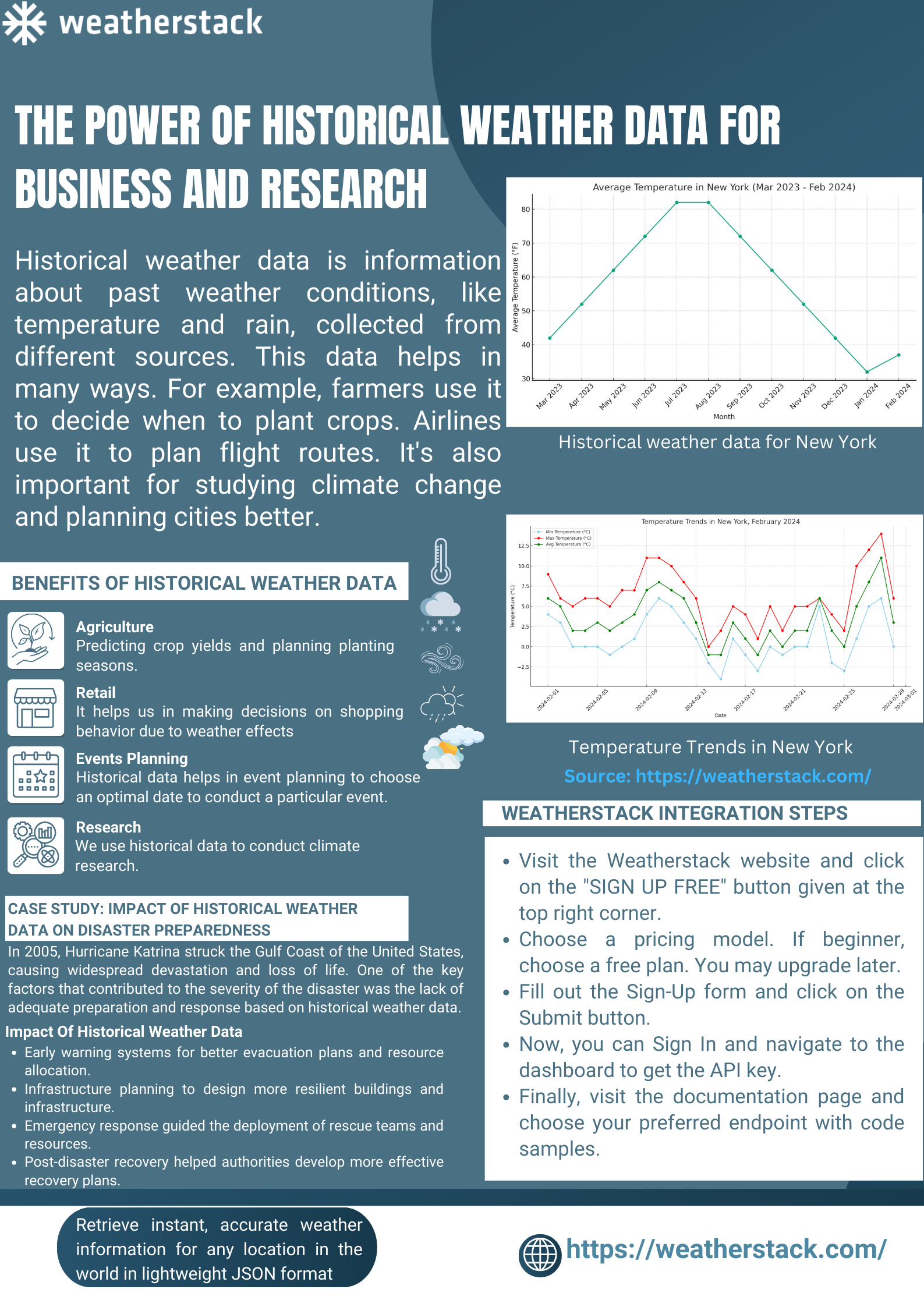Table of Contents
Understanding the Past to Predict the Future
In today’s data-driven world, historical weather data emerges as an invaluable asset for a diverse range of industries. From agriculture, where it guides planting seasons, to event planning, where it ensures the success of outdoor activities, historical weather data holds the power to influence decisions that have far-reaching consequences.
Learn more about Historical Data
The Role of Historical Weather Data in Business and Research
The Weatherstack API provides access to extensive weather archives, offering detailed insights into past weather conditions. By examining temperature trends, precipitation records, and other meteorological elements, businesses can optimize operations, mitigate risks, and tap into new opportunities. For researchers, this data is a cornerstone for climate studies, contributing to our understanding of environmental patterns and aiding in the fight against climate change.
Example API Request in Python:
Below is a Python code snippet using the ‘requests’ library to make an API request to the Weatherstack API for historical weather data:
import requests
# Replace 'YOUR_ACCESS_KEY' with your actual Weatherstack API access key
access_key = 'YOUR_ACCESS_KEY'
location = 'New York'
date = '2015-01-21'
hourly = '1'
# Set up the parameters for the API request
params = {
'access_key': access_key,
'query': location,
'historical_date': date,
'hourly': hourly
}
# Make the API request
response = requests.get('https://api.weatherstack.com/historical', params=params)
# Check if the request was successful
if response.status_code == 200:
# Convert the response to JSON
data = response.json()
# Now 'data' holds the historical weather data for the requested date and location
print(data)
else:
print(f"Error: {response.status_code}")
Before you run this code, ensure you have replaced 'YOUR_ACCESS_KEY' with the access key you obtained from Weatherstack. Also, the requests library must be installed in your Python environment. You can install it using pip if you haven’t already:
pip install requestsThe code will print out the historical weather data in JSON format or an error message if the request was not successful.
Learn more on our comprehensive documentation.

Case Study: Disaster Preparedness and Recovery
Consider the case of Hurricane Katrina; a lack of adequate historical weather data contributed to the severity of its impact. Today, armed with comprehensive weather archives, authorities can devise better evacuation plans, construct resilient infrastructure, and deploy effective emergency response strategies.

Source: Pexels
Integrating Weatherstack API for Competitive Edge
Incorporating the Weatherstack API into your business intelligence tools can streamline your operations. Whether it’s for tailoring your retail inventory to the season’s weather or for bolstering your infrastructure against extreme conditions, Weatherstack provides precise, real-time, and historical weather data that is essential for making informed decisions.
Read: How to Create a Great Weather Dashboard With a Weather API
How to Access Weatherstack’s Historical Data
The infographic attached to this post showcases the streamlined process of integrating the Weatherstack API and the profound impact historical weather data can have. Visit Weatherstack to explore our comprehensive weather data offerings and learn how our API can empower your business or research with the accuracy and precision of historical weather insights.

Conclusion
In conclusion, the capacity to analyze and understand historical weather patterns grants businesses and researchers an unmatched advantage. The insights derived from this data are not merely numbers; they are a narrative of our atmosphere’s past, a guide to the present conditions, and a forecast for the future. By embracing the power of historical weather data, we can make informed decisions that shape a more resilient and efficient world.
Ready to unlock the full potential of historical weather data for your projects?
Sign up for free today and gain immediate access to Weatherstack’s comprehensive weather data API. Begin your journey towards smarter, data-driven decision-making.


